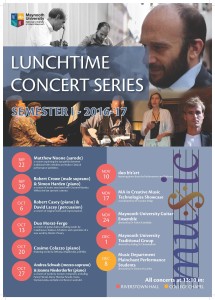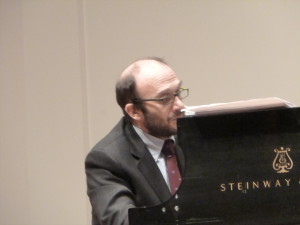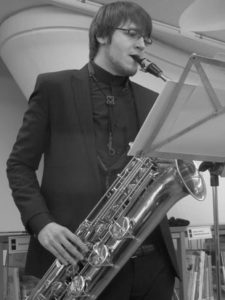| 20 Ottobre 2016 |
| 13:00 | a | 14:30 |
 Maynooth University – Music Department
Maynooth University – Music Department
Thursday, 20 October 2016 at 13:10
Lunchtime Concert Series
A LEAP IN THE DARK. Music and the First World War
A recital by
COSIMO COLAZZO, piano
Nikolaj Jakovlevič Mjaskovskij (1881-1950)
Eccentricities six pieces for piano (1917-1922) op. 25
Andante semplice – Allegro tenebroso e fantastico – Largo e pesante – Quieto – Allegro vivace – Molto sostenuto ed espressivo
Arthur Bliss (1891-1975)
Two Piano Pieces (1923)
‘Bliss’ (A One-Step) – The Rout Trot
Claude Debussy (1862-1918)
Berceuse héroique, pour rendre hommage au roi Albert I de Belgique et à ses soldats (1914)
Alfredo Casella (1883-1947)
Sonatina (1916) op. 28
Allegro con spirito- Minuetto – Finale
Pietro Mascagni (1863-1945)
Sunt lacrymae rerum! (1914)
Igor Stravinskij (1882-1971)
Piano-rag-music (1919)
Ervin Schulhoff (1894-1942)
Fünf Pittoresken (1919) op. 31
Foxtrot – Ragtime – In futurum – One-step – Maxixe
Biographical Notes on Cosimo Colazzo
Cosimo Colazzo, born in Melpignano (Lecce, Italy) in 1964, composer, pianist, orchestral conductor, is the author of a vast body of works, and has won prizes in national and international competitions. His music has been performed in various European countries, in the United States, in Latin America, in Japan, and it is published by Rai Trade – Contemporary. As a pianist, he has given concerts in Italy, in various European countries, and in the United States, and has engaged with contemporary and twentieth century musical styles, bringing particular interpretive and artistic contributions to the work of composers such as Lopes-Graça, Miaskovskij, Schulhoff, Ustvolskaya, Mompou, etc. He is a member of the research team of CESEM (Centro de Estudos de Sociologia e Estética Musical), at the Universidade Nova of Lisbon. At present he is a Professor in Composition at the Conservatorio di Musica, Trento (Italy), having been Director of that same Conservatory from 2005 to 2011. He is a faculty member and artist in residence, since 2012, at the Italian School of Middlebury College (VT), in the United States.
PROGRAMME NOTES
Nikolai Yakovlevich Miaskovsky (1881-1950), Eccentricities: six pieces for piano (1917-1922) op. 25. (Andante semplice; Allegro tenebroso e fantastico; Largo e pesante; Quieto; Allegro vivace; Molto sostenuto ed espressivo). Miaskovsky fought in the Russian army during the First World War, on the Galician front where the Russians and Austrians faced each other. He remembers that experience as a decisive one regarding his artistic development, the evolution of his language and style, as well as a factor of profound spiritual transformation of his inner self. He writes: “The war has greatly enriched my supply of internal and external impressions, and at the same time clarified my musical thought. Most of my sketches at the front have the quality of being, if not clearer, at least more objective”. He was wounded and, while convalescing, he devoted himself to the composition of his Fourth Symphony. Also during the war years he composed his very successful Fifth Symphony. His experience of the war was still in his mind as he sketched his preliminary ideas for Eccentricities, a work that he was to complete in the 1920s, imbued with murky tones, dark fantasies of sound evoked through meaningful performance markings on the score.
Arthur Bliss (1891-1975), Two Piano Pieces (1923) (‘Bliss’ (A One-Step); The Rout Trot). Bliss was active in the war, immediately volunteered for the British Army, serving with distinction in the Grenadier Guards. “My temperament demands activity, not a passive role: I only feel myself in action”. His music would reflect those changes. The War coincided with his growing maturity as man and artist. From 1917, the year America’s involvement in the War, American ‘jazz’ music had caught the imagination of young Europeans. Bliss responded to the sweeping popular dance crazes – spurred by the rise of the portable gramophone and birth of national broadcasting – with Two piano pieces: A One-Step, appropriately entitled ‘Bliss’, and The rout Trot.
Claude Debussy (1862-1918), Berceuse héroique, pour rendre hommage au roi Albert I de Belgique et à ses soldats (1914) for piano. The score, ideally addressed to the Belgian nation, declares its solidarity with the destiny of the Belgian people who, in 1914, endured invasion by the Germans, despite being a neutral country. This episode is still remembered in a striking phrase, “the rape of Belgium”, signifying all that was suffered by the Belgians as they fell victim to war crimes, notwithstanding the protection guaranteed by international agreements. Debussy voiced his abhorrence of War, which he saw as the polar opposite to Art, which it constrains and suppresses. His nationalist feelings lead him to underline his powerful sense of French identity – which has to do with specific threads of historical development and the preservation of a continuing culture, true to its own cultural traditions – but he never would have used his art to affirm the necessity of war, because he firmly believed that these two forces can never find common ground.
Alfredo Casella (1883-1947), Sonatina (1916) op. 28 for piano. The works that Alfredo Casella writes during the Great War spring from an experience of radical searching, overturning every convention of sound. These are pieces that seek out the shocking and the dissonant, that feel harmony as an experience of tone-colour, that extend the spectrum of the keyboard and also seek out states of sound, of matter almost without a form. The rhythmic cadence at times is obsessive, primitive. The dream of a precise and objective form, polemically anti-Romantic, evoked by some subtitles recalling historical conventions (see, for example, the middle movement, Minuetto), blends with this search which however appears essentially open, lacking any set boundaries. This is complex music, strongly interrogative and problematic, much like the historic times that Casella is living through.
Pietro Mascagni (1863-1945) Sunt lacrymae rerum! (1914) for piano. This is Pietro Mascagni’s contribution to an initiative by the writer Hall Caine, who had asked various European artists to take part in a joint publication to celebrate the Belgian resistance against the Germans, who had invaded Belgium despite its neutrality. The published project, King Albert’s Book: A Tribute to the Belgian King and People from Representative Men and Women throughout the World, was initiated and sustained by its future publisher, The Daily Telegraph. Mascagni wrote a short piece, whose title, Sunt lacrymae rerum!, taken from Book 1 of the Aeneid, verse 462, express a desire for a deeply felt commemoration. The writing is intentionally unadorned, created by a bare melody and above all by chords, while the harmony grows in complexity, avoiding linear paths and resolutions.
Igor Stravinskij (1882-1971), Piano-rag-music (1919). Stravinskij wrote Piano-Rag-Music in 1919 after the completion of The Soldier’s Tale. This work reflects his interest in jazz. Stravinskij achieves the deconstruction of a ragtime, where fragments of the jazz style are broken up and distorted in a grotesque Cubist image. Stravinskij, emigrated to France, was confronted with American jazz combos actively influential in Europe. Stravinsky’s knowledge of stylistic jazz properties was at first limited to scores brought to him from the United States by his colleague Ernest Ansermet. Stravinsky incorporates elements from his Russian period (ostinati, shifting accents, bitonality) with rhythmic and harmonic fragments from ragtime. The irregular meters give the piece an improvisatory character.
Erwin Schulhoff (1894-1942), Fünf Pittoresken (1919) op. 31 for piano (Foxtrot, Ragtime, In Futurum, One-step, Maxixe). The outbreak of the First World War was a decisive event for Schulhoff; it shaped him and drove his language in radical directions. Enlisted in the Austrian army, he was stationed in Prague at first, and then fought in Hungary. In 1916 he was wounded in the hand by a grenade, suffering a great nervous shock. In 1917 he served on the Russian front. By the end of the war he felt the weight of a devastating experience. He emerged from it disillusioned, but also filled with a great rage, which he expressed in provocative and experimental works, including elements of Dada, rejecting every trace of Neo-Romanticism, while politically he leaned towards Socialism. In one excerpt from Fünf Pittoresken, whose title In Futurum is both visionary and ironic, he sprinkles the page with nothing but rests and some typographic and visual jokes, thus giving space to silence, to an Otherness which has perhaps been shattered and dispersed. A game, or perhaps a serious questioning which anticipates by many years what Cage would later discover and bring to the stage. Here there is probably a different web of meanings, because Schulhoff’s work carries written within it a distraught sense of war and the decline of Europe, which has been turned into an enormous battlefield.


 Maynooth University – Music Department
Maynooth University – Music Department